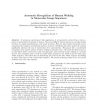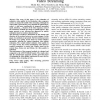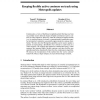BMVC
2010
13 years 9 months ago
2010
Off-line trained class-specific object detectors are designed to detect any instance of the class in a given image or video sequence. In the context of object tracking, however, o...
PAMI
2007
13 years 11 months ago
2007
—An open vision problem is to automatically track the articulations of people from a video sequence. This problem is difficult because one needs to determine both the number of p...
VLSISP
1998
13 years 11 months ago
1998
Abstract. In numerous content-based video applications, it is important to extract from a video sequence a representation for humans in motion. This task is di cult, because humans...
IVC
2007
13 years 11 months ago
2007
Computers should be able to detect and track the articulated 3-D pose of a human being moving through a video sequence. Incremental tracking methods often prove slow and unreliabl...
JCM
2008
13 years 11 months ago
2008
The scope of this paper is the estimation of subjective video quality for low-resolution video sequences as they are typical for mobile video streaming. Although the video quality ...
IJCV
2006
13 years 11 months ago
2006
Dynamic analysis of video sequences often relies on the segmentation of the sequence into regions of consistent motions. Approaching this problem requires a definition of which mo...
CVIU
2006
13 years 11 months ago
2006
This paper presents a new approach to scene analysis, which aims at extracting structured information from a video sequence using directly low-level data. The method models the se...
NIPS
2000
14 years 26 days ago
2000
Condensation, a form of likelihood-weighted particle filtering, has been successfully used to infer the shapes of highly constrained "active" contours in video sequences...
VVG
2003
14 years 26 days ago
2003
The contribution of this paper is a novel non-photorealistic rendering (NPR) system capable of rendering motion within a video sequence in artistic styles. A variety of cartoon-st...
EVENT
2001
14 years 27 days ago
2001
Automatically understanding human actions from video sequences is a very challenging problem. This involves the extraction of relevant visual information from a video sequence, re...



